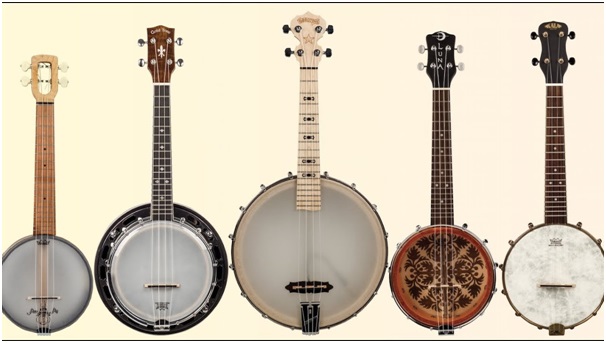Banjo, a versatile and soulful instrument, has captured the hearts of music enthusiasts for centuries. With its distinct twangy sound, the banjo has found its way into various music genres, from traditional folk and bluegrass to modern pop and rock. However, did you know that there are different types of banjos, each with its own unique characteristics and playing styles? In this article, we’ll explore the fascinating world of banjos and discover the diverse types that exist.
The Classic Five-String Banjo
The five-string banjo is arguably the most recognizable type, often associated with bluegrass and traditional folk music. It features four long strings and one shorter drone string. The fifth string is typically played with the thumb, adding that distinct “high-pitched” sound that defines the banjo. This type of banjo is commonly played in open G tuning, allowing for a variety of picking and strumming patterns.
The Four-String Tenor Banjo
The tenor banjo, as the name suggests, has four strings and a shorter neck compared to the five-string version. It is popular in Irish and Dixieland jazz music. The tenor banjo is usually tuned in fifths, making it easier for violin and mandolin players to transition to this instrument. Its bright and crisp sound adds a lively dimension to any musical ensemble.
The Plectrum Banjo
Similar to the tenor banjo, the plectrum banjo has four strings. However, it has a longer neck and is typically played with a flat pick (plectrum) rather than fingerpicking. The plectrum banjo is often used in early jazz and traditional banjo orchestras, providing a steady rhythm and chordal accompaniment to the music.
The Six-String Banjo
The six-string banjo, also known as a guitar banjo, blends the tonal qualities of a banjo with the familiarity of a guitar. It has the same tuning as a standard guitar (EADGBE), making it easy for guitarists to pick up and play. The six-string banjo opens up new possibilities for musicians to incorporate banjo sounds into various musical styles.
The Electric Banjo
As music evolved, so did the banjo. The electric banjo takes the traditional acoustic banjo and amplifies its sound electronically. It’s a popular choice for banjoists who perform in rock, fusion, or experimental genres. The electric banjo allows musicians to experiment with effects and achieve a broader range of tones.
The Open-Back Banjo
The open-back banjo is a design that predates the resonator-backed banjos commonly seen today. It lacks the resonator, resulting in a mellower and softer tone. This type of banjo is favored in old-time and clawhammer playing styles, producing a warm and nostalgic sound that harkens back to the roots of American folk music.
The Resonator Banjo
The resonator banjo, as the name implies, has a wooden or metal backplate (the resonator) attached to the back of the banjo body. This design enhances the banjo’s volume and projection, making it ideal for playing in larger venues or with a band. Bluegrass musicians often prefer the resonator banjo for its powerful and driving sound.
The Travel Banjo
Travel banjos are compact and lightweight, designed for musicians on the go. They are usually shorter in scale and may have a detachable neck for easy storage and transport. While sacrificing some volume and tone compared to larger banjos, travel banjos are perfect for practicing or jamming on the road.
The Ukulele Banjo
The ukulele banjo, also known as the banjolele, is a delightful fusion of the banjo and the ukulele. It features the body of a ukulele with a banjo head and four strings. The ukulele banjo produces a cheerful and bright sound, making it a popular choice for jazz and Hawaiian music.
The Bluegrass Banjo
The term “bluegrass banjo” refers more to a playing style than a specific type of banjo. Bluegrass banjoists often use a resonator banjo with a flatpick, employing three-finger picking techniques. This style of playing creates the signature fast and intricate picking patterns that define bluegrass music.
The Clawhammer Banjo
In contrast to bluegrass banjo, clawhammer is a distinct playing style commonly used with open-back banjos. This technique involves striking the strings downward with the fingers, creating a rhythmic and melodic sound that is prevalent in old-time Appalachian music.
The Minstrel Banjo
The minstrel banjo hearkens back to the 19th-century minstrel shows, characterized by a specific playing style and tunings. It typically has a shorter neck and a lower bridge, producing a plunky and subdued tone. Modern musicians sometimes use minstrel banjos to recreate historical American music.
The Long-Neck Banjo
The long-neck banjo is designed with an extended neck, often two or three frets longer than standard banjos. This feature allows for lower tunings and opens up new chord voicings and possibilities. The long-neck banjo gained popularity through the music of Pete Seeger, who used it to create a distinct folk sound.
The Zither Banjo
The zither banjo is a unique instrument with a drum-like body and a banjo-style neck. It usually has a high number of frets, enabling musicians to play intricate melodies. Though less common today, the zither banjo has historical significance and contributes to the diversity of banjo types.
The Vintage Banjo
Vintage banjos refer to older models, some of which may have historical or collectible value. They come in various styles, ranging from classic open-back to ornate resonator banjos. Vintage banjos are sought after by collectors and enthusiasts who appreciate the craftsmanship and history behind these instruments.
Conclusion
From the classic five-string banjo that evokes images of Appalachian hills to the innovative electric banjo that pushes musical boundaries, the world of banjos is rich and diverse. Each type of banjo brings something unique to the musical landscape, from the lively tunes of bluegrass to the soulful melodies of jazz. Whether you’re a seasoned banjo player or a curious music lover, exploring the different types of banjos can open up a world of sonic possibilities and cultural connections.


